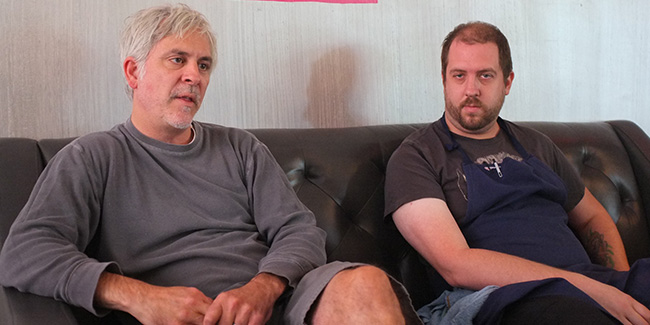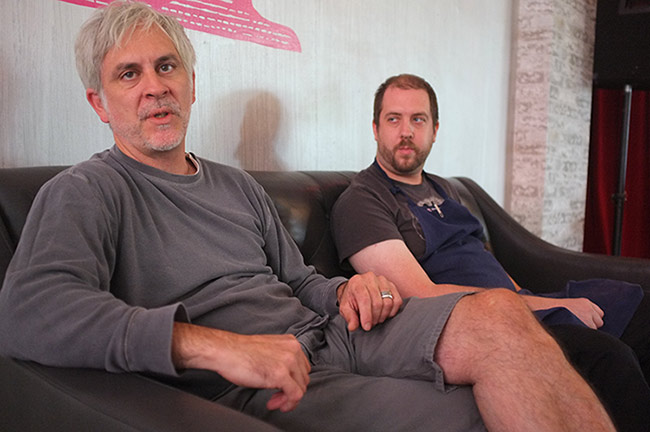
This post is sponsored by The Third Bird.
The Third Bird is the latest Kim Bartmann-helmed restaurant to open in Minneapolis [read our review here], and one of the more collaborative when it comes to local culinary firepower. We had a chance to sit down and chat with Steven Brown (above left) and Lucas Almendinger (above right), the decorated chefs behind the menu who have worked with Bartmann and sommelier Bill Summerville to establish a new mainstay in a storied Loring Park location.
HEAVY TABLE: Lucas, you used to be a cabinet maker, and I hear you got in touch with Steven and you two have been cooking since. I’m curious about how you two struck up this mentor/protégé relationship in the kitchen.
STEVEN BROWN: Well first of all, turns out that not only did I grow up with and go to high school with Lucas’s father, but … On Lucas’ maiden voyage to the hospital, with his mother who was pregnant with him, my mother drove them, apparently, in my father’s Corvette. Although we’d never met, and I think the last time I’d seen his dad Rob had to have been 1981, the day we matriculated…
HEAVY TABLE: So you two have a history …
BROWN: Yes, unintended or otherwise!
LUCAS ALMENDINGER: Yeah, I was working at WA Frost, and I sent Steven a friend request on Facebook and he responded with, “Is your dad’s name Rob?” And then I found out they went to high school together. We ended up meeting up and talking; we were doing a catering event with Landon Schoenefeld, and I sort of invited myself along.
HEAVY TABLE: Had you been cooking much before then?
ALMENDINGER: Not a lot … my mom owned a restaurant when I was in high school, so I had done it, but I didn’t want to do it forever … so I went into guitar making, moved up here, fell into the cabinet making industry, got burned out on that, and decided to get into cooking again. And here we are.
HEAVY TABLE: Where did you two start working together first?
BROWN: Tilia. We struck up a friendship; we’d get together and have coffee on occasion, trade cookbooks.
HEAVY TABLE: And now you’re here at The Third Bird. So how did this all come together with Kim Bartmann? Seems like it’s been quite a collaborative effort.
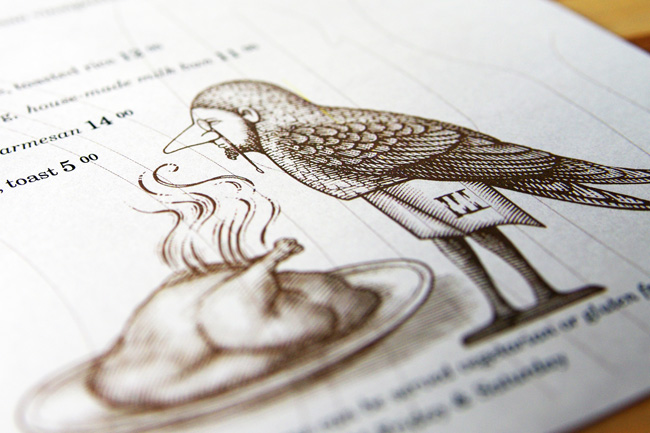
BROWN: Yeah, I’ve known Kim for a long time, and admired her many and sundry places. She would occasionally have me do an event or wine tasting, or I’d see her in one of her restaurants. So she called me up and said, “Hey, I’ve got a new project coming up. Would you be interested in talking about it?” And I said, “Ah, I don’t know … I’d have to think about that a little bit.” And a few weeks later, I’d gone to Italy with Bill Summerville, and we’d struck up a friendship based on our traveling together. And Kim said, “Well I think Bill’s going to be involved in this too. …” So my level of interest went up a fair amount. So we just started talking about the things we know and are able to do, and to put them together, collaboratively, to see what the end result could be. Sometimes you’re a one-man band, and then all of a sudden you find an opportunity to not only do something different and new — which is always exciting to me — but to do it with people you admire and respect, and hopefully learn something along the way, yourself. So … it’s a great opportunity. Sometimes you get stylistically put in a position, and the press can put you in a place. It can be easy to become typecast a little bit.
HEAVY TABLE: Thinking about Kim’s restaurants — she has a great footprint in Minneapolis, from the French bistro style of Barbette to the supperclub feel of the Red Stag. How does The Third Bird stand out? Is there a niche here that you’re going for, or a particular vision?
BROWN: Well, I cut my teeth and worked for many years at the long lost Loring Cafe right next door. I worked at Nick & Eddie, which obviously was formerly in this space … and to me, personally, I think looking out that window right now, seeing those trees … I sort of see Loring Park as this great flower that is underappreciated, at best, in our city. I’ve always thought this location, in the summertime — sun going down in the west, the light reflecting off the buildings, you’re overlooking this bucolic park — it sort of looks like this Maxfield Parrish painting. I just think it’s an amazing, beautiful location that people need to know more about. It’s an edge-of-downtown oasis thing, where you get out of the fray of the city, but you’ve got one foot in it, too.
HEAVY TABLE: So you’d say the context of this particular location informs the vibe. The history here is significant.
BROWN: There’s clearly expansion going on. Again, I think this is what I see as a rejuvenation of what was once a really happening, glorious block 15 to 20 years ago, that for whatever reason, has fallen out of favor — excepting Lurçat, of course, which is still going strong. But you know, Nick & Eddie didn’t make it, Joe’s Garage … so there’s a lot of energy and excitement in the immediate neighborhood with the new stuff coming in.
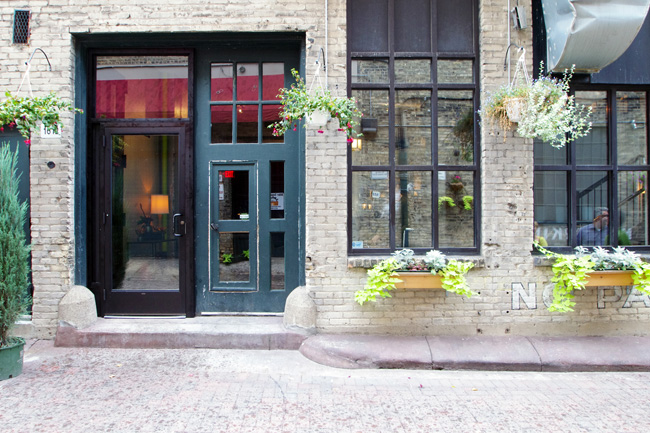
HEAVY TABLE: It seemed that Nick & Eddie maintained a certain brand of exlusivity — there was something slightly impenetrable about it if you weren’t “in the club,” so to speak.
BROWN: I would tell you that you’re 100 percent correct. If you were part of the club, you came in and got treated like rock star royalty, but if you were outside that immediate circle, it could be — could be — pretty cold. That was the Nick & Eddie vibe — the artists, and the … what’s that Gram Parsons song: “Hanging out with the cowboys, hookers and the thieves”?
HEAVY TABLE: Is that something you see changing here with The Third Bird?
ALMENDINGER: Absolutely.
BROWN: Yeah, I don’t think that’s our thing — we want people to come here and have great food, great wine, great service, at a great price. That’s the vibe. This is a relaxed, casual atmosphere with a lot of what I call ATD — attention to detail. So, the same effort that Bill put into the wine list or training the staff; the same effort that Kim and her compadres put into redesigning the space, and reimagining the alley entrance so you come in and look out onto the park … the whole space and they way it relates to the food, it’s a lot of attention to detail. The phraseology I like to use is intelligent sourcing — of course, we’re going to find the best product we can.
HEAVY TABLE: That seems to be a strong through-line in all of Kim’s — and your — establishments. Do you expect to see a lot of Scott Seekins in here?
ALMENDINGER: So far he’s been in here five or six times …
HEAVY TABLE: Does he have his own special menu yet, or a dedicated booth?
ALMENDINGER: Not yet, we’re working on it …
BROWN: French fries and olive oil … when Scott was at Nick & Eddie, that was his jam. Extra crispy fries and a side of olive oil for dipping. Salt the daylights out of it, dip ’em in oil. Scott Seekins is a living breathing Minneapolis institution on a lot of levels.
HEAVY TABLE: Steven, you’ve obviously created something hugely successful in Tilia, which is a very personal place for you. How does your approach change in a role like this? What’s the difference between running your own place, and partnering with another restaurateur to bring your vision on board?
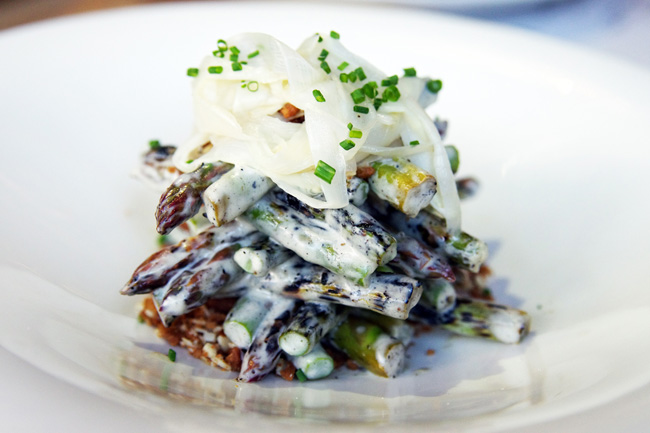
BROWN: Well, first and foremost I’ve always taken the mantle that regardless of whether I own the restaurant or work at it, that I ran it like I owned it. Of course, having owned my own restaurant, I’ll tell you that it’s a very different veil to pierce. You can imagine yourself being in that position, but until you actually are, you know, the guy writing the checks … either way, you run it in a way that you see fit for the time and the place, and beyond that, I guess, there is a bit of a relief ,on a certain level, to sort of be excused from those responsibilities. The great thing about Kim’s operation is that she has enough people in place to support those systems. You’re not having to invent the wheel from day one, so you can really focus in on those things, hopefully, that you take pleasure in and that you’re good at. As far as my own experiences at Tilia — I think my goal has been to take the things I’ve learned, not only at Tilia but throughout my career — and not that they’re universal — but try and tease the things out of that we can bring to this, and make it as fruitful as possible.
HEAVY TABLE: Lucas, what drives you as a chef? What do you hope to develop here, and do you have a signature approach that you feel will put your stamp on The Third Bird?
ALMENDINGER: I think that what drives me is a constant evolution at getting better at what I do every day: learning more, and slowly pushing the rock up the hill, so to speak. And that’s what I really want this restaurant to be — about more of a constant evolution, and what the team thinks a Midwestern restaurant can really be, in the sense that we’re very adamant about local sourcing and a seasonal approach. If we can take that, and do it in a manner that we’re all excited and happy about, that’s the goal. The restaurant as it sits today, and what it’ll be three months from now and three years from now — it will be hopefully vastly different for the better. I expect the food to get better every day. The menu, the whole thing, is a living organism in a sense. I think Tilia is a perfect example of this. You go in to a project, and everyone is excited; everyone’s hopefully on the same page; everyone has a sense of what the restaurant is going to be. Then you unlock the doors for the first time, and it’s kind of like you have to bend to the will of the restaurant a little bit too, and it’s going to dictate what it is in a manner.
HEAVY TABLE: Is there any particular ingredient that either of you love to work with the most, or are continually inspired by?
ALMENDINGER: It changes…
BROWN: Yeah, it changes with the time of year, like right now we have a forager who’s bringing us lobster mushrooms, which we’re loving right now. You know, the window in Minnesota for late summer and early fall is small, just three to four weeks, and it’s the same time the harvest season is kicking in. I think it’s always sort of my favorite time of the year … I love this Wallace Stevens poem, there’s this pretty famous quote, “Death is the mother of beauty.” You know, spring is hopeful, and everything is new … but fall is so beautiful, because everything is coming to fruition, but everything is dying at the same time. I think that’s the awesome part of cooking. Stylistically, emotionally, the things that you bring in become really a part of the fabric of what’s going on, and as that changes, as Lucas was saying, that’s kind of what makes up the layers of the cake, so to speak. How’s that for an explanation?
The Third Bird
1612 Harmon Pl, Minneapolis, MN 55403
612.767.9495

